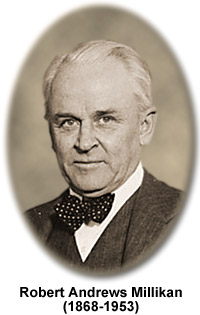Robert Andrews Millikan
(1868-1953)

Robert Millikan was an American physicist who was awarded the Nobel Prize for Physics for his experiments on the photoelectric effect and on the charge carried by an electron. The renowned scientist also is well known for his studies of cosmic rays and his role in establishing the California Institute of Technology as a leading research establishment. Throughout his life, Millikan was dedicated to reconciling the realms of science and religion, publishing many books on the topic, including Science and Life (1924), Evolution in Science and Religion (1927), and Time, Matter, and Values (1932). His rural upbringing and the profession of his father, Reverend Silas Franklin Millikan, likely influenced his attitudes toward both fields.
Millikan was born on March 22, 1868 in Morrison, Illinois and took a job as a court reporter after he graduated from high school. He soon enrolled, however, at Oberlin College in Ohio, the alma mater of his mother, Mary Jane Andrews. As an undergraduate, Millikan began the typical Classics curriculum and particularly enjoyed mathematics and Greek. In fact, his eventual interest in physics is often attributed to his Greek professor, who reportedly urged him to teach an elementary physics course despite his unfamiliarity with the field, claiming that if Millikan could do well in his Greek, then he was capable of teaching physics. Later, in his autobiography, Millikan would suggest that his first experience teaching physics was probably the best teaching he had ever done due to his enthusiasm for the topic, which he was carefully trying to master one step ahead of his students. Millikan’s interest in physics led him to pursue graduate degrees in the field, which he received in 1893 (MS) and 1895 (PhD). He subsequently spent a year abroad, as was customary for postgraduates at the time, in Germany, where he carried out research at the Universities of Berlin and Göttingen. Millikan returned to the United States in 1896 when he was offered a position as assistant to Albert Michelson at the University of Chicago’s Ryerson Laboratory.
Millikan eventually began teaching at the University of Chicago, where he became a full professor in 1910. Early in his career he developed a number of physics textbooks that were widely utilized for many years. However, it appears that his famous Millikan oil-drop experiment had a greater influence upon his academic career, since the publication describing the experiment and Millikan’s results was released shortly before he received his professorship. The Millikan experiment was designed to determine the charge of an electron, an objective that had already been attempted by a number of other scientists, but never with such a high level of success. This was primarily because other physicists had tried to determine the charge of an electron through observations of a cloud of water droplets exposed to an electric field, while Millikan refined the process by observing single drops of a liquid, first water and then oil, which did not pose the same evaporation problems as water. By repeating his experiment numerous times, Millikan demonstrated that the charge on a single electron was a constant, 1.592 • 10(E-19) coulomb, a number slightly smaller than the contemporay value of the elementary charge (1.602 • 10(E-19) coulomb). The difference in the values has been commonly attributed to Millikan's utilization of an innaccurate value for the viscosity of air.
Millikan’s oil-drop experiment helped firmly establish that electrons are discrete particles, a claim that was under significant dispute at the time, and gave credence to Niels Bohr's quantum theory of the atom. Subsequent experiments carried out by Millikan were also important for providing evidence that Albert Einstein’s formula mathematically explaining the photoelectric effect, which he proposed in 1905, was correct. Later in his career, Millikan became increasingly involved in the broader aspects of science, acting as an advisor for various foundations and corporations, raising money for Caltech, and contributing to the formation of national science policies. He also continued his research efforts, however, and his studies of penetrating radiation at Caltech resulted in his coining the term cosmic rays to describe the phenomena of extraterrestrial radiation. Millikan retired from his chief executive’s position at Caltech in 1946, but continued carrying out his studies almost until his death in 1953.
